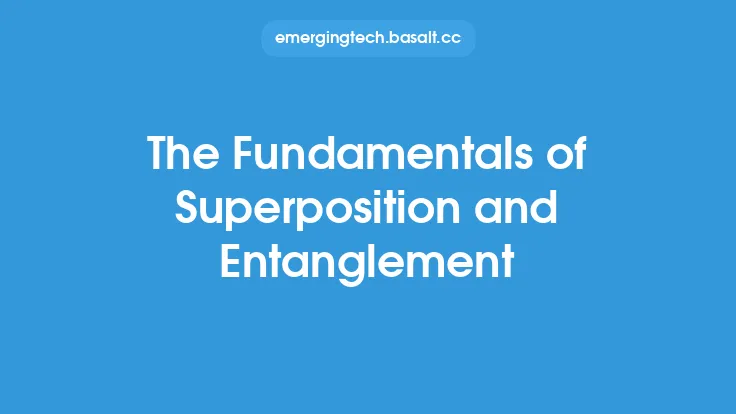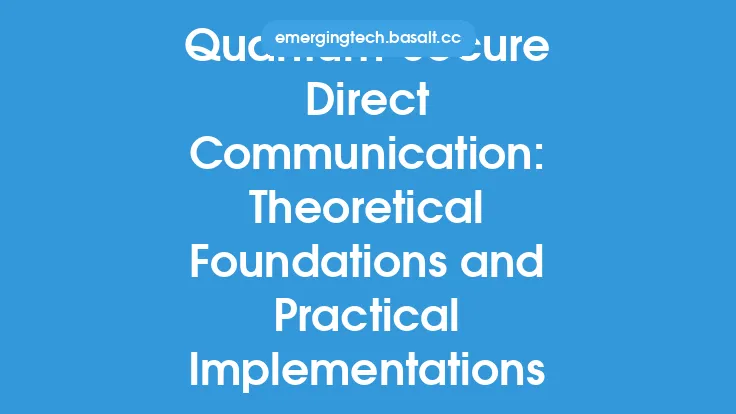The principles of quantum mechanics have led to the development of a new paradigm in information processing, known as quantum information. At the heart of this paradigm are two fundamental concepts: quantum entanglement and superposition. These phenomena, which are unique to the quantum world, enable the creation of quantum systems that can process and transmit information in ways that are not possible with classical systems.
Introduction to Quantum Entanglement
Quantum entanglement is a phenomenon in which two or more particles become correlated in such a way that the state of one particle cannot be described independently of the others, even when they are separated by large distances. This means that measuring the state of one particle will instantly affect the state of the other entangled particles, regardless of the distance between them. Entanglement is a key resource for quantum information processing, as it enables the creation of quantum systems that can perform tasks such as quantum teleportation, superdense coding, and quantum cryptography.
Quantum Superposition
Quantum superposition is another fundamental concept in quantum mechanics, which states that a quantum system can exist in multiple states simultaneously. This means that a quantum particle, such as an electron or a photon, can exist in a superposition of states, such as spin up and spin down, or 0 and 1, at the same time. Quantum superposition is a critical component of quantum information processing, as it enables the creation of quantum systems that can process multiple possibilities simultaneously, leading to exponential scaling in computational power.
Mathematical Formulation of Quantum Entanglement and Superposition
The mathematical formulation of quantum entanglement and superposition is based on the principles of linear algebra and Hilbert spaces. In this formulation, quantum states are represented as vectors in a complex vector space, known as a Hilbert space. The state of a quantum system is described by a wave function, which is a mathematical function that encodes the probability amplitudes of the different states of the system. Quantum entanglement is represented by the tensor product of the wave functions of the individual particles, while quantum superposition is represented by the linear combination of the wave functions of the different states.
Quantum Entanglement and Superposition in Quantum Information Processing
Quantum entanglement and superposition are the foundation of quantum information processing. They enable the creation of quantum systems that can perform tasks such as quantum computation, quantum simulation, and quantum communication. Quantum computation, for example, relies on the ability of quantum systems to exist in a superposition of states, which enables the simultaneous processing of multiple possibilities. Quantum simulation, on the other hand, relies on the ability of quantum systems to become entangled, which enables the simulation of complex quantum systems.
Quantum Entanglement Swapping and Superposition Measurement
Quantum entanglement swapping is a process in which two particles that have never interacted before become entangled. This process is based on the ability of quantum systems to become entangled through a common interaction with a third particle. Quantum superposition measurement, on the other hand, is the process of measuring the state of a quantum system that exists in a superposition of states. This process is based on the ability of quantum systems to collapse to a single state upon measurement, which is known as wave function collapse.
Applications of Quantum Entanglement and Superposition
The applications of quantum entanglement and superposition are numerous and varied. They include quantum computation, quantum simulation, quantum communication, and quantum cryptography. Quantum computation, for example, has the potential to solve complex problems that are intractable with classical computers, such as factoring large numbers and searching large databases. Quantum simulation, on the other hand, has the potential to simulate complex quantum systems, such as chemical reactions and material properties. Quantum communication and quantum cryptography, finally, have the potential to enable secure communication over long distances, which is essential for many applications, including financial transactions and military communications.
Challenges and Limitations of Quantum Entanglement and Superposition
Despite the many potential applications of quantum entanglement and superposition, there are several challenges and limitations that must be overcome. One of the main challenges is the fragile nature of quantum states, which are prone to decoherence and noise. Decoherence is the loss of quantum coherence due to interactions with the environment, while noise is the random fluctuation of quantum states. Another challenge is the difficulty of scaling up quantum systems to large numbers of particles, which is essential for many applications. Finally, there is the challenge of developing robust and reliable methods for measuring and controlling quantum states, which is essential for quantum information processing.
Conclusion
In conclusion, quantum entanglement and superposition are the foundation of quantum information processing. They enable the creation of quantum systems that can process and transmit information in ways that are not possible with classical systems. While there are several challenges and limitations that must be overcome, the potential applications of quantum entanglement and superposition are numerous and varied, and include quantum computation, quantum simulation, quantum communication, and quantum cryptography. As research in this field continues to advance, we can expect to see the development of new technologies and applications that exploit the unique properties of quantum systems.





